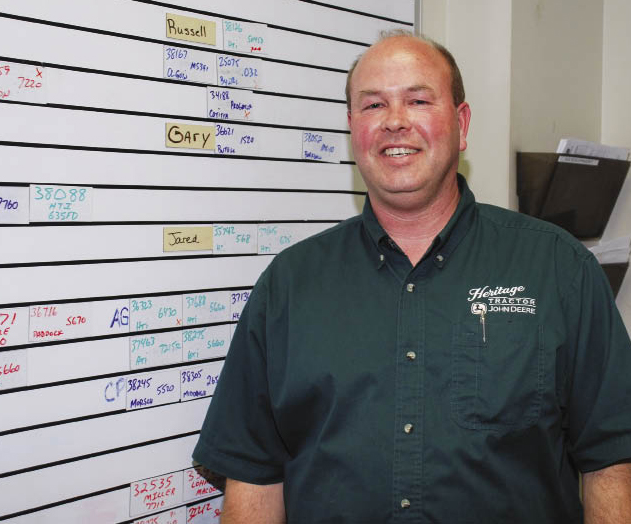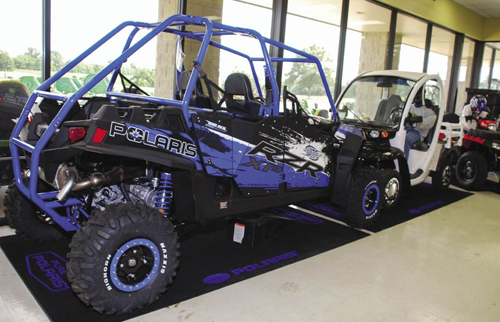Heritage Tractor's new approach to parts delivery is helping drive recent growth, including a push in online marketing of products and the acquisition of 3 new locations.
The dealership added a parts van this spring to more efficiently and quickly meet customers’ demands for parts. The van has had a significant effect on parts revenue. McGhee says in one month last year, the van transferred more than $174,000 in parts, which was 17% of the total parts purchases for the month.
“It’s hard to say how many of those parts sales we would have gotten without the van. However, if you can instantly tell a guy when we can get a part, that takes going to another dealership out of the equation,” McGhee says.
He says the dealership continues to ask, “How else can we build our parts business and be more efficient?” They answered that question this summer by adding a trailer for the parts van.
“Originally we saw it was something that had potential, so, fortunately, we bought a van that supported hooking up a trailer. Now, we move smaller products, too, such as blades, tillers and even mowers. We don’t have to send a special truck to transfer that kind of equipment between our locations.”

This color-coded white board helps assistant service manager John Newman communicate with his service team. It also serves as a double-check against the dealership’s service planning software and helps technicians visualize the overall orders.
The van now has a two-day route, covering about 250 miles each day as it travels to the northern locations on one day and the southern locations on the next. Based on its financial performance, Heritage is now considering adding a second parts van to further increase speed and efficiency.
“We had the biggest parts month ever for our organization in June of 2013 because of that flexibility to move parts and equipment,” McGhee says. “Customer satisfaction is what the parts van really does for us. It shows our customers the value of our larger organization — a larger resource for them.”
The van offers advantages to other departments as well, such as sales. “That guy is worth his weight in gold,” says Kevin Bradford, rural lifestyle salesperson for Heritage’s Baldwin City location, about the parts driver, Alex Langton. Not only do Heritage’s 10 locations give Bradford the inventory he needs, but Langton gets him that inventory faster. “It makes it easier for us to close a sale.”

Heritage Tractor sales-person Kevin Bradford says rural lifestylers do their research regarding tractors and mowers, but need his expertise to understand attachments.
The van has even improved communication between the stores. For instance, each dealership already had a shelf for stacking mail, promotional materials or supplies that needed to be transferred. However, there was no schedule for when those supplies were transferred and who delivered them. Now, each location can count on receiving that information several times a week.
Communication Drives Service
Communication is a strategy that also drives success in Heritage’s service department, both with its service technicians and with customers.
“This place has been here a long time. We have a good reputation and they know our people are going to shoot straight and be honest,” says John Newman, assistant service manager. “I sometimes have to tell them, ‘You may not like what I have to tell you, but it has to be done.’”
He says he makes sure customers know the difference between when he is able to give a firm quote and when he is estimating repairs. In those situations, Newman stays in contact with the customer by phone or email, based on their preference. He says on a typical day he may spend 2 hours on the phone with customers.
The other part of customer service is getting the repair done on time. Heritage has 3 service technicians dedicated to its rural lifestyle customers. The department has 30 or more machines in the shop at a time during its busy season, and it strives to have all repairs done within a week. Newman says they track and communicate through several methods to keep repairs moving. Its primary method is its John Deere business system, Equip, which includes parts and service management functions. Plus, they have two Heritage-specific methods: instant messaging on their computers and color-coded magnets on a white board.
The instant messaging is for short and quick communication, such as a part that might be needed. It saves time walking back and forth. The white board helps Newman double-check orders in the business management system and gives the team a visual look at what’s in process and what’s waiting.

Heritage Tractor’s retail display shows off equipment for working and playing on properties this fall, such as racing utility vehicles.
Each magnet lists the repair order number, the customer name and the type of equipment. That information is written with a blue marker to indicate the customer dropped off the equipment. Purple shows Heritage picked it up. Red indicates a service call and green indicates it’s an internal order, such as an equipment set-up.
The white board lists the technicians’ names and the magnets are moved to that technician when the job is assigned. They are then moved to another board when the repairs are finished and the equipment is ready for pickup or delivery. The technicians use the board as a way to work in smaller jobs when they are waiting for parts on larger repairs.
Newman says some repairs never make it to the dealership and he is glad to work through those, too. “A lot of times customers are just looking for suggestions on how to fix something themselves. We start walking through what was happening before the machine shut down. People just want to talk to somebody and know they will be treated right.”





Post a comment
Report Abusive Comment